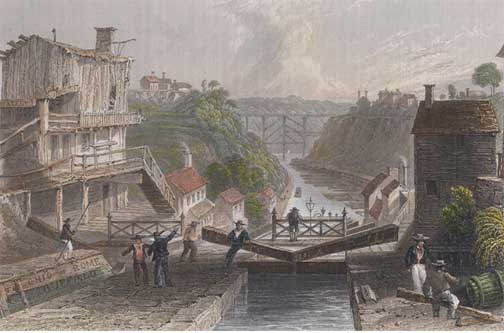1825 Erie Canal Opened

The Erie Canal was officially opened on October 25, 1825. It linked Lake Erie and all the Great Lakes to the Hudson River and New York. Construction on the canal began in 1816. The canal spanned 363 miles, and its completion helped to speed up the development of the West.

| The Erie Canal was planned to be 363 Miles (580km) long. It would need to rise 600 feet from the Hudson River to Lake Erie. It was to be 40 feet wide and 4 feet deep, with a towpath built along the side. The longest canal in the United States at this time was 26 miles long. Construction on the canal began, symbolically, on July 4th 1817. The first part of the Erie Canal to be built was the flat part stretching from Rome, NY to Utica, NY. This section of the canal did not require any locks. The first stage of the canal was an instant success. Income from the traffic immediately covered the carrying cost of the canal. Building on the canal's fast success, it was then time to tackle the difficult part, the building of 50 locks. No one building the canal had any previous experience constructing locks. The US did not have any Engineering schools at that time. The builders needed to learn as they worked. |  |
9,000 workers were engaged in the building of the Erie Canal. Many of the laborers were Native Americans. However, a large number of the remaining workers were new Irish immigrants. Many workers died as the canal was being built. Many small companies were contracted to build the canal, in order to spread around the work and support to as many small companies as possible. The Eastern section of the canal from Brockport to Albany was opened on September 10, 1823.
 |
The Erie canal was completed on October 26, 1825. Its completion was toasted as the “Great Celebration”. Governor Clinton began his trip down the canal, with a cannon salute. As part of the celebration, cannons were placed along the length of the canal within earshot of each other. Cannons went off over the entire along the length of the canal, down the Hudson River. The cannon fire returned to Buffalo, three hours later, as one cannon after another went off in both directions.
|
The Erie Canal lived up to the dreams of its promoters. It opened the west for settlement and commerce. Within a few years it had carried $15 million of commerce. This dollar value represented twice the amount of commerce that had gone down the Mississippi River. Suddenly, it was possible to buy wheat in the Midwest and ship it to New York, where it could be sold to Europe. In 1850, the Erie Railroad was completed. The Erie Railroad become the first railroad to connect the East Coast with the Great Lakes. Until then the Erie Canal was the only way to move goods between the East Coast the Great Lakes and beyond. Even after the Erie railroad was completed the canal remained the least expensive way to move freight. The Erie Canal quickly exceeded its planned capacity, and was enlarged. The enlargement of the Erie Canal was completed in 1862. In 1918, the New York State Barge Canal replaced the Erie Canal. The canal's traffic continued to grow until the early 1950’s, when the air and truck traffic began to seriously impact the traffic on the canal. Today, the Erie canal is used mainly for recreational boaters.
 >
>